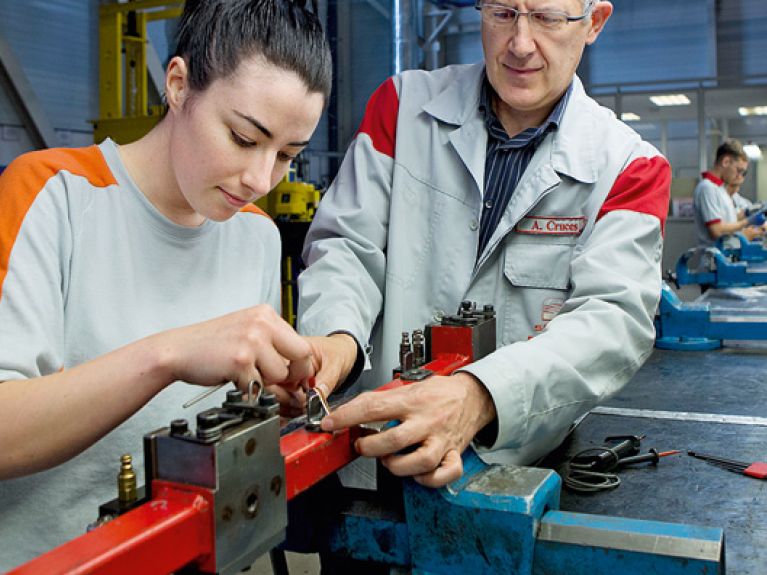Learning German-style
Spain is working to improve its training system: SEAT has introduced the dual vocational training system based on the German model.

Marc Estapé is standing at the lathe machining his workpiece, a conveyor roller. Spiral-shaped turnings fall away, just as they should. There is no instructor looking over the 21-year-old’s shoulder – “That’s how much they trust us,” says Estapé. Yet the lathe is “really a pretty expensive piece of machinery”. But Estapé knows how to operate it like an old hand. He is just completing his second year of training as a toolmaker at the Escuela de Aprendices in Barcelona, the apprentice school of car manufacturer SEAT, which belongs to the German Volkswagen Group. The school has been around for a long time, since 1957, almost as long as SEAT itself, but nearly two years ago it refurbished its training programme. The young people there now complete dual vocational training, German-style – a minor revolution. Marc Estapé is one of the 167 apprentices currently receiving training at the Spanish carmaker.
“After finishing high school, I had to make up my mind,” explains Estapé, “either go to university or do an apprenticeship. Here at SEAT, I saw the prospect of a future career.” A future career – for Spaniards of Estapé’s generation, something akin to winning the lottery. In Spain, more than 880,000 young people between the ages of 16 and 24 are currently looking for a job. Going to university used to be considered the best route to a secure job – but those days are over. “Friends of mine are studying engineering,” says 19-year-old Dulce Polo, who is just completing her third year of training at the SEAT plant in Martorell, just outside Barcelona. “And then they end up working as waiters.” That’s a fate that will most likely be spared Marc and Dulce. They have a good chance of being kept on by SEAT after finishing their training.
Spain developed into an industrialised country in the 1960s, and that was accompanied by a change in mentality. “Parents wanted their children to do better than they had,” says Manuel Moreno, head of training at SEAT. So they sent their kids to university: 40.7% of today’s 30- to 34-year-olds in Spain have a university degree – compared with 33.1% in Germany. “Meanwhile, vocational training lost its prestige,” complains Moreno. According to OECD figures, 8.4% of adults in Spain have completed an apprenticeship – compared with 55.8% in Germany.
The 2012 labour law reform has brought some changes, however: Spain has taken initial steps to transform its overly theoretical and regimented Formación Profesional into a practice-oriented dual vocational training system. Now Spanish companies can conclude training contracts with young people. Previously, vocational school students gained work experience only through placements or internships, which were often unpaid or poorly paid at best – an unsatisfactory situation not only for the students but also for the companies.
The German Josef Schelchshorn, who took up the post of Human Resources Head at SEAT four years ago after a long career at Audi, explains how he asked himself this question when he started the job: “Are we really doing enough in terms of training? And my colleagues’ answer was that, basically, we have to provide extra training if the young people are kept on.” The labour market reform came just at the right moment. In autumn 2012, the VW subsidiary introduced the dual system of vocational training based on the German model, the first company in Spain to do so. The apprentices are now SEAT employees from the first day of their training, and they receive a trainee salary.
In return for the pay, trainees have to meet stiffer demands. Instead of completing 2,000 hours of theoretical and practical training in two years, the SEAT trainees complete 4,624 hours in three years. A good quarter of that is theory, the rest practical training, first at the Escuela de Aprendices and then at the company itself –1,852 hours of on-the-job training in all. “We tell our trainees: You’re going to be working hard – flat out – for the next three years!” says training head Moreno. “Some people think the trainees want to do as little work as possible – but what they want is to be given a chance!” And they get it at SEAT. Which is why interest is keen: 912 young men and women have applied for one of 60 new trainee places this year. The company can choose from the best. When the young people have completed their training, there will be no more need for an “extra portion”: they can start work in the factory as fully fledged employees.
In recent years, Spaniards have heard a lot about the dual vocational training system, and a small private German school – which has just changed its name from “ASET” to “FEDA Business School” – has been offering a range of training programmes based on the German model in Madrid and Barcelona since 1982. It is now an officially recognised German Vocational School Abroad and receives support from the Federal Office of Administration’s Central Agency for Schools Abroad (ZfA). But now the idea is finally set to spread throughout Spain. The German-Spanish Chamber of Commerce, which presented this year’s German-Spanish Business Award to SEAT for introducing the dual vocational training system, is trying to help where it can, advising Spanish companies that want to follow the Spanish carmaker’s example. According to Spanish Education Ministry figures, this year there are already nearly 10,000 vocational school students completing dual vocational training in Spain, about twice as many as the previous year – but still a very small number compared with the total of more than 660,000 vocational school students in Spain.
In Portugal, too, the German-Portuguese Chamber of Industry and Commerce is one of the driving forces behind efforts to improve the dual vocational training model there; it operates three training centres of its own – in Lisbon, Porto and Portimão (Algarve) – under the name “DUAL”.
“Dual vocational training is currently on everyone’s lips,” says SEAT HR head Schelchshorn. “And there are now lots of companies asking us: SEAT, what’s your secret? Can we take a look? Can we adapt the system? Of course. Our doors are open to all comers.” Ideally, the SEAT model will find imitators in Spain. “The hardest part with this sort of change is making a start,” says training head Moreno. “Companies must be willing to do their bit – voluntarily. But I’m optimistic that in five years’ time the dual vocational training system will have caught on in Spain.” ▪

